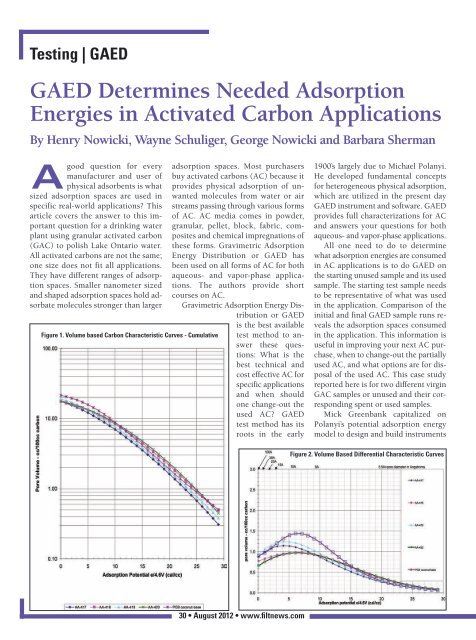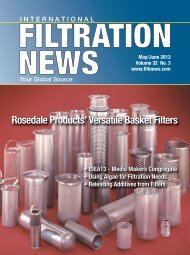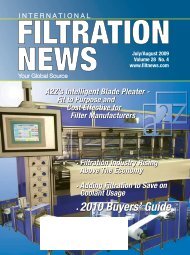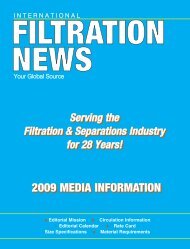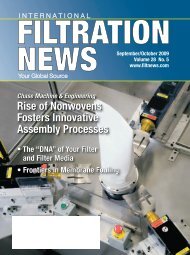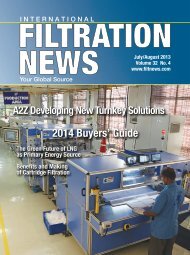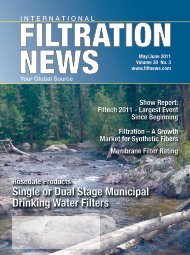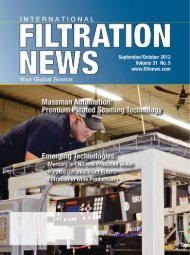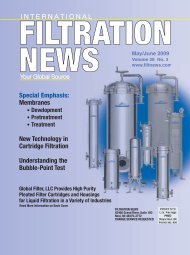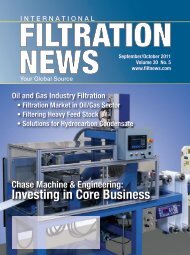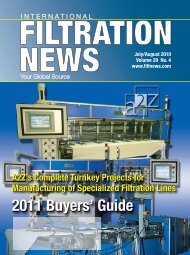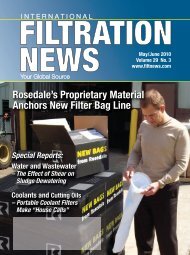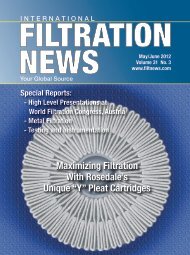2013 Buyers' Guide 2013 Buyers' Guide - Filtration News
2013 Buyers' Guide 2013 Buyers' Guide - Filtration News
2013 Buyers' Guide 2013 Buyers' Guide - Filtration News
You also want an ePaper? Increase the reach of your titles
YUMPU automatically turns print PDFs into web optimized ePapers that Google loves.
Testing | GAED<br />
GAED Determines Needed Adsorption<br />
Energies in Activated Carbon Applications<br />
By Henry Nowicki, Wayne Schuliger, George Nowicki and Barbara Sherman<br />
Agood question for every<br />
manufacturer and user of<br />
physical adsorbents is what<br />
sized adsorption spaces are used in<br />
specific real-world applications This<br />
article covers the answer to this important<br />
question for a drinking water<br />
plant using granular activated carbon<br />
(GAC) to polish Lake Ontario water.<br />
All activated carbons are not the same;<br />
one size does not fit all applications.<br />
They have different ranges of adsorption<br />
spaces. Smaller nanometer sized<br />
and shaped adsorption spaces hold adsorbate<br />
molecules stronger than larger<br />
Figure 1. Volume based Carbon Characteristic Curves - Cumulative<br />
adsorption spaces. Most purchasers<br />
buy activated carbons (AC) because it<br />
provides physical adsorption of unwanted<br />
molecules from water or air<br />
streams passing through various forms<br />
of AC. AC media comes in powder,<br />
granular, pellet, block, fabric, composites<br />
and chemical impregnations of<br />
these forms. Gravimetric Adsorption<br />
Energy Distribution or GAED has<br />
been used on all forms of AC for both<br />
aqueous- and vapor-phase applications.<br />
The authors provide short<br />
courses on AC.<br />
Gravimetric Adsorption Energy Distribution<br />
or GAED<br />
is the best available<br />
test method to answer<br />
these questions:<br />
What is the<br />
best technical and<br />
cost effective AC for<br />
specific applications<br />
and when should<br />
one change-out the<br />
used AC GAED<br />
test method has its<br />
roots in the early<br />
1900’s largely due to Michael Polanyi.<br />
He developed fundamental concepts<br />
for heterogeneous physical adsorption,<br />
which are utilized in the present day<br />
GAED instrument and software. GAED<br />
provides full characterizations for AC<br />
and answers your questions for both<br />
aqueous- and vapor-phase applications.<br />
All one need to do to determine<br />
what adsorption energies are consumed<br />
in AC applications is to do GAED on<br />
the starting unused sample and its used<br />
sample. The starting test sample needs<br />
to be representative of what was used<br />
in the application. Comparison of the<br />
initial and final GAED sample runs reveals<br />
the adsorption spaces consumed<br />
in the application. This information is<br />
useful in improving your next AC purchase,<br />
when to change-out the partially<br />
used AC, and what options are for disposal<br />
of the used AC. This case study<br />
reported here is for two different virgin<br />
GAC samples or unused and their corresponding<br />
spent or used samples.<br />
Mick Greenbank capitalized on<br />
Polanyi’s potential adsorption energy<br />
model to design and build instruments<br />
Figure 2. Volume Based Differential Characteristic Curves<br />
30 • August 2012 • www.filtnews.com


